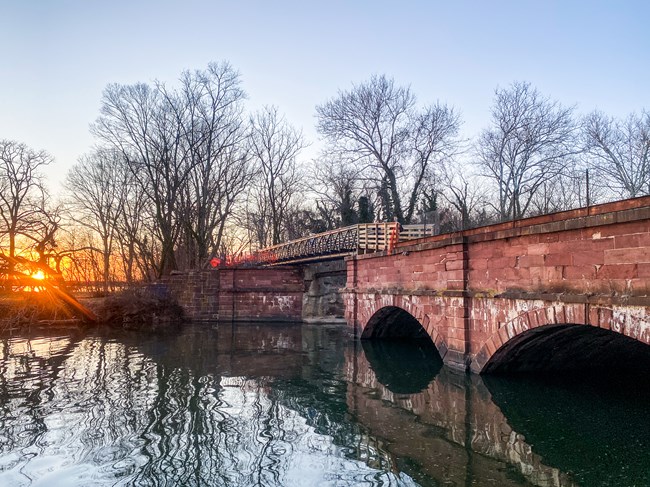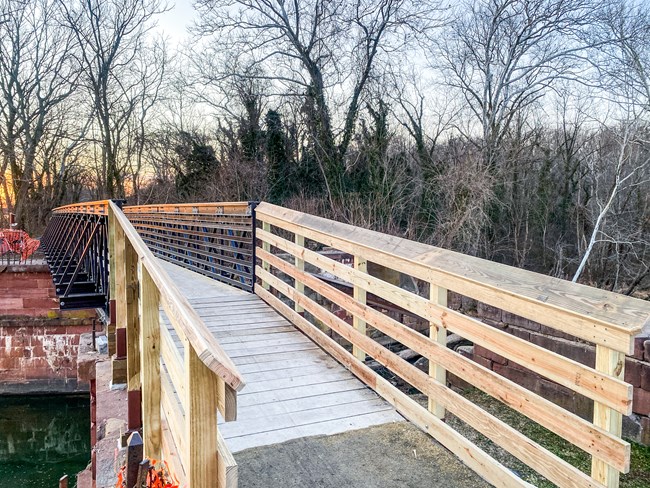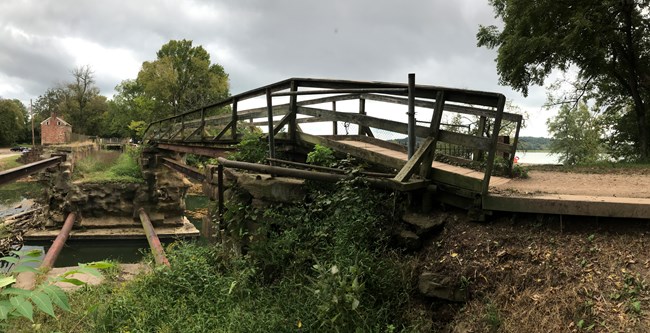
NPS | Joe Reed, Park Engineer Mile 22.8: The Seneca Creek Aqueduct is open.The park replaced the existing pedestrian bridge across the west arch of the historic Seneca Creek Aqueduct (mile 22.8) in Poolesville, Maryland. The previously existing 1970s era bridge reached the end of its service life. 
NPS | Joe Reed, Park Engineer NO CURRENT DETOURS AND CLOSURESThe Seneca Creek Aqueduct at mile 22.8 is OPEN.. FREQUENTLY ASKED QUESTIONS (FAQs)What is the need for the project?The west arch of the Seneca Creek Aqueduct failed during a flood event in September 1971. The arch failure has been stabilized by the National Park Service (NPS) but never restored. A timber pedestrian bridge was installed shortly after the failure in the 1970s to bridge across the west arch. This bridge has experienced significant weathering and deterioration over the years, and it has reached the end of its service life. The bridge needs to be replaced to prevent any further deterioration and to ensure visitor safety at the Seneca Creek Aqueduct crossing. What does the project include?The project consists of removing the existing timber pedestrian bridge and its associated support materials, installing a pre-cast concrete abutment on the upstream side of the aqueduct, and placing the new Fiber Reinforced Polymer (FRP) composite pedestrian bridge. The concrete abutment on the upstream side will be offset away from the historic masonry in order to protect it. The National Park Service (NPS) anticipates the contractor to rely on a crane set up in the Rileys Lock parking lot to perform the work. 
NPS | Joe Reed, Park Engineer Where will the project take place?This project took place at the Seneca Creek Aqueduct on the C&O Canal towpath at mile 22.8, approximately 8 miles downstream of Lock 25 – Edwards Ferry, and 0.7 miles upstream from Lock 23 – Violettes Lock. When will the project begin and end?The project began in late November 2021, and the aqueduct was re-opened in February 2022. How will this project benefit park visitors?With the project complete, the method of crossing the failed arch of the Seneca Creek Aqueduct is safer and more sustainable for visitors. How will this project impact natural and cultural resources?Every project the NPS executes undergoes review by a multidisciplinary team to ensure compliance with Section 106 of the National Historic Preservation Act (NHPA), National Environmental Policy Act (NEPA), and other federal, state, and local laws. Permits authorizing the work from other regulating agencies (e.g. Maryland Department of the Environment) have also been issued. What is the park doing to protect those resources during the project?NPS resource protection experts, engineers, and the contractor’s team have surveyed the adjacent historic features at the project site. The new bridge has been placed so that the new, precast abutment on the west (upstream) side is offset away from the historic masonry. NPS representatives monitored construction activities, along with the contractor’ operations and visitor safety during the project with the goal of safely protecting the environment surrounding the project. Every project undertaken by the NPS is conducted in compliance with the National Environmental Protection Act (NEPA), the National Historic Preservation Act (NHPA), and other regulations. How is the project funded?The contract for the removal of the existing pedestrian bridge and installation of the new FRP bridge at the Seneca Creek Aqueduct in Poolesville, MD was funded from the National Park Service’s Repair Rehabilitation Program. 
NPS | Joe Reed, Park Engineer |
Last updated: July 20, 2023
